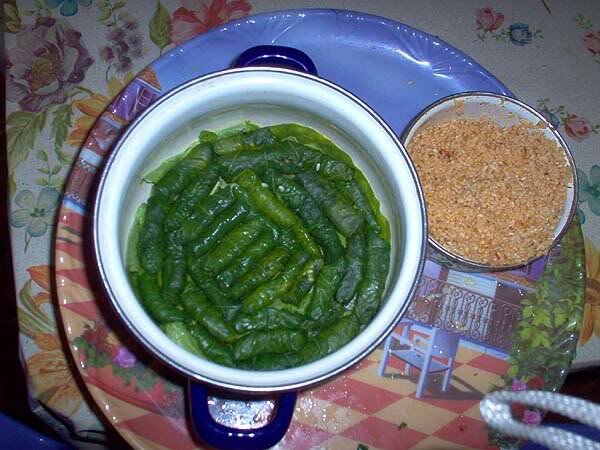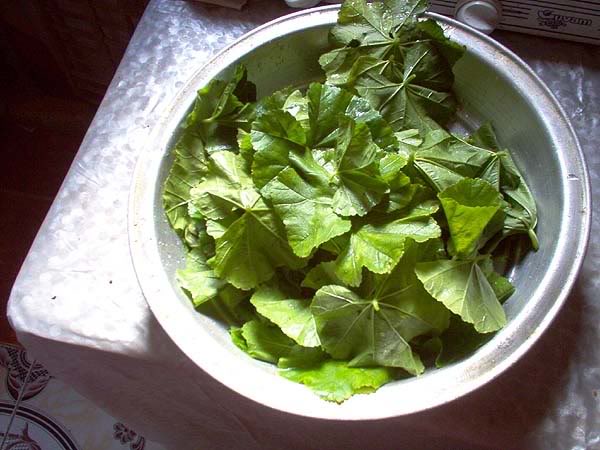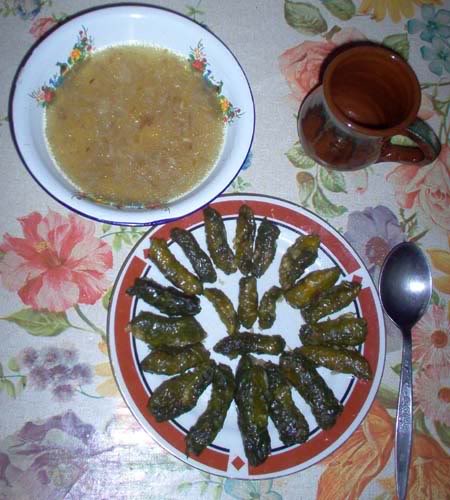A better title for this post is probably, “Why God Made Restraunts”
Within this post, you will learn how to make stuffed grape leaves, and also find recipes for delicious roasted chicken, great chicken soup, and also rich pasta sauce, all made from scratch. If you are vegetarian, you can omit the chicken from the broth and still get a delicious onion soup.
Preserved grape leaves can be purchased in a jar at middle eastern and mediterranean grocery stores. That’s the easy way. I, on the other hand, have no grocery store nearby, and Abu Khalid at the little ‘dukan’ down the street will scandal my husband’s wife all over the village if I ask him to import me a jar of grape leaves from someplace exotic like Cairo or Alexandria. So if you are like me, you’ll just have to pull them off the vine. We’ll save the post for growing your own grapes up on the roof for another time, when you return for another visit!
So, you can use young tender grape leaves, turnip leaves, cabbage, romaine lettuce, any edible green leaf that is large enough to work with. Large leaves, like some varieties of grape leaves, and of course cabbage, must be cut down to proper size. A leaf or a section the size of the palm of your hand (don’t include your fingers – palm only) is a very good size for making stuffed [anything] leaves.
.
.
.
Here is a photo of ‘khobiza,’ a delicious green leafy plant growing wild all around my oasis. My grapevines were still too young for harvesting leaves for mahshee, so I picked these khobiza leaves, instead:
In english, this lovely plant is known as egyptian mallow, or cheeseweed.
This is an excerpt from http://en.m.wikipedia.org/wiki/Malva_parviflora:
“Malva parviflora is an annual or perennial herb that is native to Northern Africa, Europe and Asia and is widely naturalised elsewhere.[1] Common names include cheeseweed[1], cheeseweed mallow[1], egyptian mallow[1], least mallow[1], little mallow[1], mallow[2], marshmallow[2], small-flowered mallow[3], small-flowered marshmallow[4] and smallflower mallow[2]. M. parviflora leaf extracts possess anti-inflammatory and antioxidant activities.[5] It has a decumbent or erect habit, growing to 50 cm in height.[3] The broad leaves have 5 to 7 lobes and are 8 to 10 cm in diameter.[3] It has small white or pink flowers with 4 to 6 mm long petals.[3]”
There is not the slightest difference if you use khobiza or grape leaves for this recipe, so I hope you will forgive me for using photos of khobiza instead of grape leaves.
So, let’s get started. First, you will need to make some soup broth, for pouring over your stuffed leaves when you are ready to cook them.
If you boiled a chicken yesterday, much better – you can use that broth. Boiling (for about 20 minutes) a chicken in just enough salty water to cover it will give you a fantastic tasting chicken (throw in a couple cloves of garlic and an onion before boiling, for extra good taste). Take it out of the soup and put it under the broiler till brown and you will love this chicken! The broth in the cooking pot is not to be underestimated, either!
If you didn’t make the chicken, you still need soup, so just use 3 or 4 Tbs chicken boullion and a medium pot full of water. Add salt until the water tastes salty and then boil this broth for a few minutes. If you want really good soup, sautee some onion and garlic in the pot before adding the water and the boullion. Or, if you are vegetarian, skip the boullion and just do the sautee.
Next, you will need to make some good, rich, thick spaghetti sauce to coat your rice before stuffing it in the leaves.
You might want to make the sauce yourself at least one day ahead so all this work won’t exhaust you. Or buy some Ragout, that works too. I think the biggest reason people get married around here is because they need to work, and to eat. Somebody has to work, and somebody else has to cook. Otherwise, nobody will eat! Around here, food takes all day in the kitchen to prepare, because everything is made from scratch – it’s a serious timesuck, but I admit the results are mostly worth it!
To make a really rich, thick pasta sauce, cut up about 6 or 8 good size tomatoes into chunks and hold them aside for a bit. Mince 4 or 5 cloves of garlic and one good size onion, and then pour about 2 or 3 Tbs of your favorite cooking oil into your bigger, heavier frying pan. Turn the heat up to med high and saute the onion and garlic until lightly browned.
Now add the tomatoes, and stir them well. Leave this to cook, and mince up a small bunch of fresh parsley, or cilantro, or both, and a little bunch of fresh dill, and add this to the pan, too. If you like, mince up some fresh peppers and throw them in, as well. Next sprinkle in some black pepper and cumin fairly liberally. By the way, cilantro, dill and cumin are the signature spices of Egyptian food. If you don’t love them already, you will learn to, or maybe you will starve!
Turn the heat to medium-low and let the tomatoes cook down to mush. Slow down at any point you like the look of the sauce if you will use it for pasta. This is the right time to add the salt and adjust the spices, then boil for another minute and stop. But for the stuffed grape leaves, turn the heat down to very low to let the sauce steam off all its water and you have something better than any tomato paste you ever saw or tasted in your life. I usually make a huge frying pan full, because when it reduces down to tomato paste perfection I save it in the freezer. It thaws and reconstitutes perfectly with a little water whenever I want a quick dish of spaghetti, or I’m making pizza.
See why it’s easier to do this a day ahead? This sauce will need to cool, too, before you can work with it. But it can be cooling while you prepare the leaves, if you don’t have a jar of leaves in the brine close at hand. This step is the same for the turnip leaves, or cabbage, or any other fresh green leaves.
Boil water in a pot big enough to recieve all the fresh leaves you will stuff. When the water is boiling, drop in the leaves and boil them for 3 or 4 minutes. Turn off the heat and let the water cool – replace some of the hot water with cold water to speed things up. It’s easier to work from this water, than to remove the leaves to work with later. On a tray they tend to stick together and become a real pain in the neck. It’s much easier to pull one leaf out individually from the water and let it drain a little before stuffing it.
Cabbage is different only in the fact that you are dealing with a whole head – cut off the stem and use a long sharp knife to core as much of the stem from the inside of the head, and remove the big heavy tough leaves. But don’t try to separate the rest of the leaves from the head, just make a pot big enough to contain the whole head at least half way under water, roll it around in the pot to blanch all the head, and gently cut/peel the leaves off individually while blanching. Drop the blanched leaves into another big pot of cold water.
Here’s a photo of the leaves after blanching. The pot on the left is lined with romaine lettuce leaves, but I’ve also used some of the heavier cabbage leaves, or thick slices of potatoes, even thick slices of onion:
Use a medium size, fairly heavy cooking pot for cooking the stuffed leaf rolls. By lining the inside bottom with a layer or two of leaves or other vegetables, you are protecting the rolls from burning or sticking to the pot.
Now we sit down and drink a really strong cup of extra sweet Kenyan tea. It will give you energy to keep going, insha’Allah (God Willing)!
Ready? Mix about 2 cups of uncooked rice with about 1/4 cup of the cooled tomato paste. The rice should be coated completely, with a little excess sauce, but not gooey. Here’s a photo of the rice mix, some leftover pasta sauce and a few khobiza leaves:
Place a leaf on a tray in front of you and drop about a tablespoon or two of rice mix in one spot not too close to an edge. Fold up the leaf the way the guy at the deli wraps your sandwich: First cover the rice with the closer edge, then fold over the left side and the right side of the leaf to cover the middle and roll it all up into a little tight roll. Something like this:
Place the little roll into the pot and repeat. Fill the bottom of the pot tightly with rolls in one layer and then make a new layer on top of that. Keep going until you run out of leaves, rice, room in the pot, or patience, whatever comes first. If it’s cabbage, you will run out of patience first!
Adjust the amount of rice mix according to the leaf size and your comfort level. You will be surprised how little rice it takes to make a very beautiful little stuffed grape leaf. Here in Egypt the ladies pride themselves on how small a piece of leaf they can use to make pretty little rolls of “Mahshee Wara Ainab”. A tiny piece of leaf might hold only 10-15 grains of rice, but it works and it comes out beautiful! They make very delicate little appetizers and taste fantastic!
Here’s the pot with the first layer completed:
Remember the chicken soup you made earlier? Put it on to boil now. After the soup boils, pour it slowly over the layers of rolls in the pot until about 1/4″ of the top layer of rolls is still showing. Don’t completely cover the rolls with soup, as the boiling will take care of the top. Then find a china plate (ceramic, glass, anything except plastic) that fits into your pot and lay it on top of the rolls. This is to keep everybody snug while cooking. I used the lid for the next smaller size pot:
Cover the pot and Boil on medium for a long time. You will be waiting for the water to all boil away, and you can tell by listening for the boiling to sound like it’s coming from the bottom of the pot. If you look inside, you will see if the boiling is down to the bottom yet, but the more you look, the longer it will take. When the water finally boils down to the bottom, turn the heat down to med-low and let more water boil away. You will start to smell the cooking of the leaves or potatoes in the bottom of the pot -it smells wonderful! Turn it off!
(LoL – If you smell burning, you probably are only burning the bottom leaves- that’s what they’re there for – to save your mahshee!) The mahshee in this picture took about 45 minutes to boil away the water, but it was only enough food for one meal. Usually Egyptian women make a great big pot full, probably because after this big job in the kitchen they go on strike for a few days, and a big pot of mahshee takes quite a while to cook, usually about 2 hours or so. Finally, it’s done:
And if you’re not to tired to eat after all this, here’s the mahshee on the plate (with some of the onion soup on the side):
Next time you see Stuffed Grape Leaves on a menu in your favorite Greek Restraunt, you’ll have a much better appreciation for the chef, won’t you?!
B’il Hannah wa Shiffah! (Enjoy!)
;^)










A great recipe I can’t wait to try out. I love Stuffed Grape Leaves and those adventurous enough to try them! I wish more would.
I came up with my own version of a Stuffed Grape Leaves, inline with an Arab style. While different from your own, I think mine is a unique take on the dish. I’m new to the Food Blog scene and would love some feedback from a pro like you. Check out my recipe if have time.
http://persnicketypanhandler.blogspot.com/2012/09/warak-einab-bil-zait.html
LikeLike
Wow! !! Already drooling … lol Superb presentation and method details,dear Aisha! I also use vine leaves or cabbage leaves or lettuce to stuff them with rice + minced meat ( optional ) , but I never use tomato sauce, I first cook them and then I make egg lemon sauce with the broth which I add in the cooked meal or I put it in a big gravy boat and we add to our plates as much as we like.
Sending you hugs, Doda 🙂 xxx
LikeLike
Oh yes, Doda, it is the greek dolmades that really make me drool, with the avgolemono sauce, oh my, it’s my favorite food on earth! I have learned how to make the αυγολεμονο sauce, finally! It took some practice to learn how to incorporate the eggs without cooking them. Greek food is the best in the world for me, but Egyptian food is remarkably similar. We make “macarona bil bechamel” that is quite similar to παστιτσιο, which I dearly love, and now that you got me started, I just got a great recipe from Sue Dreamwalker for σπανακοπιτα! ΛΟΛ ευχαριστω γλυκη μου νομιζω οτι σχεπζω ολα τα ελλινικα εχω! Lol, it’s been ages since I used any greek, I never was very good, but I’m definitely very rusty now! If I have my dictionary and do a good review from my vocab flashcards, I might be able to catch back up, but my husband is always whining that I dont spend enough time learning arabic. But it’s not my big love like greek! σαγαπω πολυ φιλη μου! ♥♥♥ ;^)
LikeLike
Dumfounded by your Greek knowledge and all these little details you know ! Now,I’m dead sure that Greek blood is running in your veins … Arabic must be as difficult as Greek,but bless him his heart and start studying it to make him happy …

BTW,when I make spinach pie I add Feta cheese ( optional ),but I add a lot of fennel which gives it a very special flavour.
Do you use fennel in cooking ? I just love it !!!
Love ~(˘▾˘~) ~(˘▾˘)~ (~˘▾˘)~ and a big bear hug my dear friend Aisha ,you are such a dear 🙂
Doda xxxxxxxx
LikeLike
Wow, fennel in your σπανκοπιτα? Θαυμασια! Omg arabic is a pain in my neck, but τα ελληνικα ειναι ευκολα, δεν γνοσσω γιατι! Maybe because I do have some greek blood in my heart, who knows??! ♥♥♥ and hugs to you too, dear sweet Doda! Thanks for your beautiful friendship! ♥♥♥ ;^)
LikeLike
Oh, Doda, I forgot to tell you, here in Egypt we drink fennel “tea” by boiling the seeds – it’s very delicious and healthy, I like to refrigerate it and drink it cold! Do you do this in Greece, too?
♥♥♥ ;^)
LikeLike